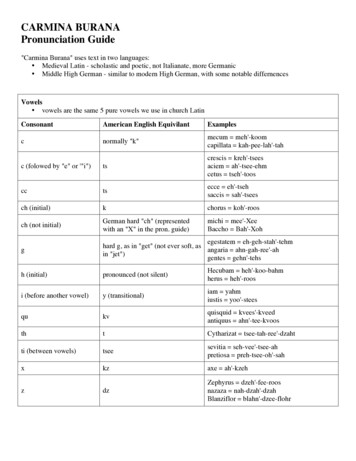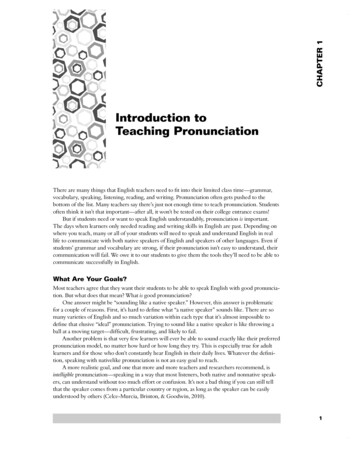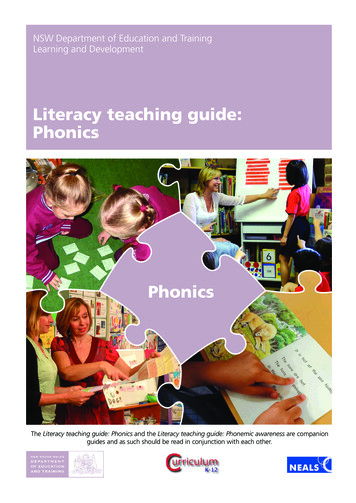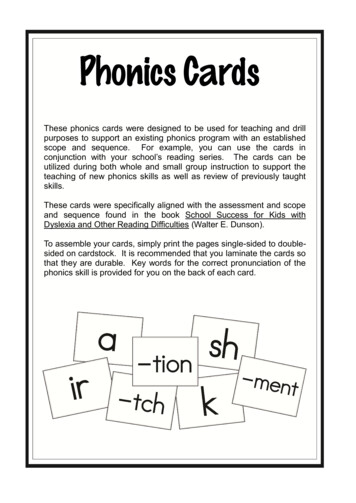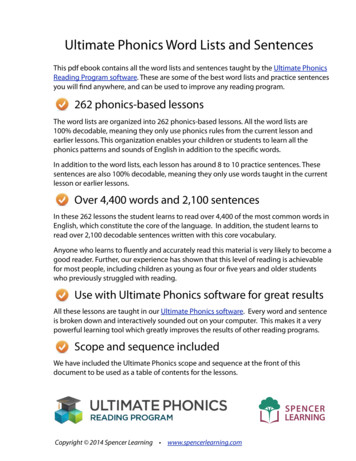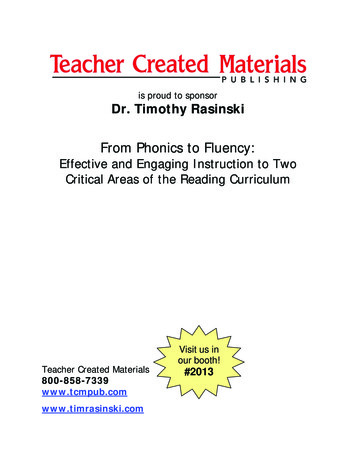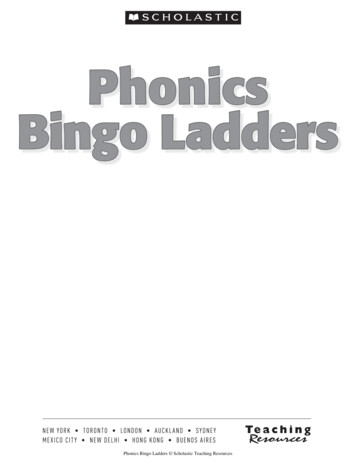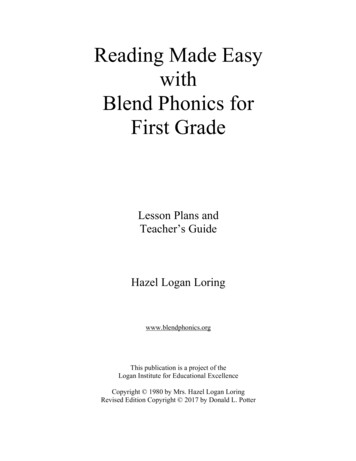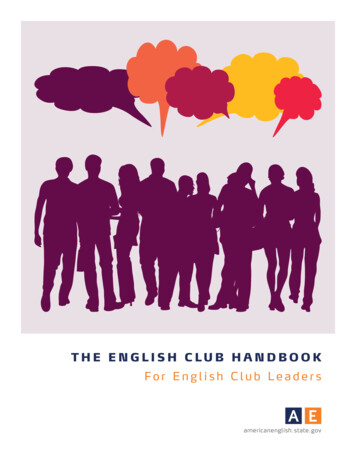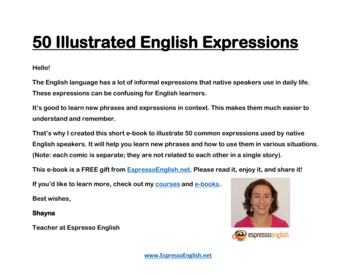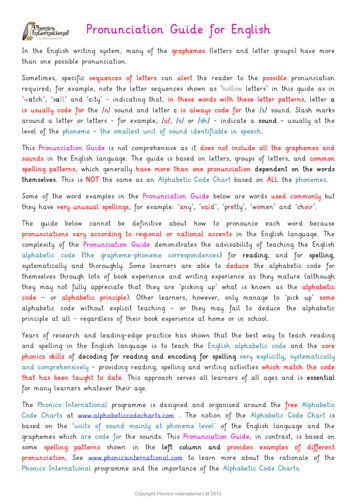
Transcription
Pronunciation Guide for EnglishIn the English writing system, many of the graphemes (letters and letter groups) have morethan one possible pronunciation.Sometimes, specific sequences of letters can alert the reader to the possible pronunciationrequired; for example, note the letter sequences shown as ‘hollow letters’ in this guide as in‘watch’, ‘salt’ and ‘city’ - indicating that, in these words with these letter patterns, letter ais usually code for the /o/ sound and letter c is always code for the /s/ sound. Slash marksaround a letter or letters - for example, /o/, /s/ or /sh/ - indicate a sound – usually at thelevel of the phoneme – the smallest unit of sound identifiable in speech.This Pronunciation Guide is not comprehensive as it does not include all the graphemes andsounds in the English language. The guide is based on letters, groups of letters, and commonspelling patterns, which generally have more than one pronunciation dependent on the wordsthemselves. This is NOT the same as an Alphabetic Code Chart based on ALL the phonemes.Some of the word examples in the Pronunciation Guide below are words used commonly butthey have very unusual spellings, for example: ‘any’, ‘said’, ‘pretty’, ‘women’ and wtopronounceeachwordbecausepronunciations vary according to regional or national accents in the English language. Thecomplexity of the Pronunciation Guide demonstrates the advisability of teaching the dences)forreading,andforspelling,systematically and thoroughly. Some learners are able to deduce the alphabetic code forthemselves through lots of book experience and writing experience as they mature (althoughthey may not fully appreciate that they are ‘picking up’ what is known as the alphabeticcode– or alphabetic principle). Other learners, however, only manage to ‘pick up’ mayfailtodeducethealphabeticprinciple at all - regardless of their book experience at home or in school.Years of research and leading-edge practice has shown that the best way to teach readingand spelling in the English language is to teach the English alphabetic code and the corephonics skills of decoding for reading and encoding for spelling very explicitly, systematicallyand comprehensively – providing reading, spelling and writing activities which match the codethat has been taught to date. This approach serves all learners of all ages and is essentialfor many learners whatever their age.The Phonics International programme is designed and organised around the free AlphabeticCode Charts at www.alphabeticcodecharts.com . The notion of the Alphabetic Code Chart isbased on the ‘units of sound mainly at phoneme level’ of the English language and thegraphemes which are code for the sounds. This Pronunciation Guide, in contrast, is based desexamplesofdifferentpronunciation. See www.phonicsinternational.com to learn more about the rationale of thePhonics International programme and the importance of the Alphabetic Code Charts.Copyright Phonics International Ltd 2013
Pronunciation Guide for Englishgraphemesand spellingpatternsaexample wordsincluding common and rare yalso alwaysmanagefirst u/schwa/ul/alternative /o/ /l/chalkpalmhalfalmostwalk //or/sugarschwaharecare dareYou are funny.awkward/or/ /l/quartercollaraw/or//a/ grey background commonpronunciation/e/bananaalmultiple phonemes/ar/manywatersaidphonemes and/a/tableaisounds/er//air//ar/awfulaware/or//a/ /w/Copyright Phonics International Ltd 2013or/u/
ayetray/ai/She says that I am funny./e/egg/e/emueame he she we bepretty/i/acnebetween/i/ andeatreachheadear-eau/ee/each eautiful butterfly/y oo/It rained./d/She skipped./t/He acted./u/ eipt/ee//er/adherehere/eer/wherethere/air/you wereCopyright Phonics International Ltd 2013/er/or/u/
-ew-eynewnews/y oo/crewlongkey/ee/monkeybetween/i/ andbird of preyi-iethey/i/I am behind the tree./igh/piano/ee/radiochiefbriefbelieveHe cried./igh/friends/e/fiesta/ee/ /e/octopus/o/yo-yono go sosonmothermoveto do whowolves/oo/short/oo/ointment/oi/coincidence/oa/ /i/choir/w/ /igh/on board/o/ /n/Once upon a time.oolong/i/wolfon/oa//u/womenoi/ee/between/i/ t Phonics International Ltd 2013/ee//ai/insectmovieo/oo//w o/ /n/shortlong/u//oo//oo//ee/
-oororoudoorfloorboardspoorly/long oo er/or/or/fork/or/world/er/sailorschwahistoric building/o/ /r/“ouch”/ou/shout out loudsoupyoutouchoughdoughthough althoughuthroughlongbought oughtschwa/er//ou/ your housefour/or/savour the flavourschwabowtomorrow/oa/owldown town/ou/umbrellaschwa/er//u/unitedpull/y oo/short/oo/penguin/w/supermanlongbarbecue/y oo/tube/u//or/flourpushu-eor/oo/our houseblue/u//oa//ou/unicorn-ueor/oo/ploughno thoroughfareowlong/er//u/thoughtour/or/true clue gluecute cubeCopyright Phonics International Ltd 2013long/oo//oo//y oo//u/or/u/
bu /b/) /i/guitar(gu /g/) /i/intuition/y oo/ /i/purecure obscuresure/or/treasureschwabeg/b/ /e/behind/b/ /i/debtdoubt chairssoft c: ce ci cy/k/ /s/schoolsoft c/k/chef/sh/cicity/s/ /i/-cimagician/sh/pronunciation/s/ /ee/desk/d/ /e/demand/d/ /i/detour/d/ /ee/feathers/f/of/v/f/u//ch/chameleondeor/b/ /t//k/succeed/er//t/cataccentch/y oor/Copyright Phonics International Ltd 2013soft csoft c
ggirl/g/giraffe/j/courgette/zh/I get it!/g/ /e/gentle touch/j/ me/n/signal/g/ /n/guitar/g/gust of wind/g/ /u/leleg/l/ soft g: ge gi gy/m//m/ /b/nnet/n/-njungle/ng/-nggong/ng/bangles/ng/ /g/danger/n/ /j/pneumatic drill/n/hypnotic/p/ eceptionCopyright Phonics International Ltd 2013soft gsoft g/p/ /t//p/ (ti /sh/)
ququequeensqueezebouquet/k/question/k w/ /e/plaquere/k w/queue/k/reggae/r/ /e/remind/r/ /i/theatreschwamacabre/r/ /u/ssnake/s/-sfries/z/treasure/zh/scan the horizon/s/ /k/scissors/s/house/s/cheese/z/sisit/s/ /i/-sitelevisionststill running fast/s/ /t/-st-castle/s/swsweets/s/ /w/sword/s/-resc-sethdivisionlistenthistlethin thick pathover therethe this that/er//zh/unvoicedvoiced/t/ /i/-tistation/sh/-turematureadventureCopyright Phonics International Ltd 2013/th//th/tinpicture/u/soft c: ce ci cytiimmatureor/t/ /y oor//ch u/
twtwicetwotwins/t/ /w/2vevest-vedovewawatch/t//v/ /e/lovehavewas/v/swap/w/ /o/wagwh/w/ /a/wheelwhen what why /w/who is it?worwhole onewormxycan be ‘breath’/h/work worth/w/ /er/worn/w/ /or/fox/k s/exam/g pyflybetween/i/ andby my why trycymbals/ee//igh/symbols 1 2 3 /i/The complexities of the English Alphabetic Code include:1) one sound (phoneme) can be represented by one, two, three or four letters:e.g. /k/ c,/f/ ph,/igh/ igh,/ai/ eigh2) one sound can be represented by different spellings (graphemes):e.g. /oa/ is represented by: o,oa,ow,oe,o-e,eau,ough3) one spelling (grapheme) can represent multiple sounds:e.g. ‘ough’:/oa/ though, /or/ thought, /oo/ through, /ou/ plough, /u/ thoroughThis Pronunciation Guide demonstrates that learning to read the English language is not straightforward.It is easier to teach and learn reading and spelling in English, however, when beginners are notexpected to read and write independently with words that have complex and unusual code.The SyntheticPhonics Teaching Principles are based, therefore, on introducing the alphabetic code systematically ichmatch,introduction of the alphabetic code in the synthetic phonics programme.Copyright Phonics International Ltd 2013moreorless,theincremental
Slash marks around a letter or letters - for example, /o/, /s/ or /sh/ - indicate a sound – usually at the level of the phoneme – the smallest unit of sound identifiable in speech. This Pronunciation Guide is not comprehensive as it does not include all the graphemes and sounds in the English language. The guide is based on letters, groups of letters, and common spelling patterns, which .
